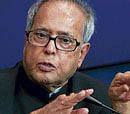Step up credit to job-creating sectors, says FM

Finance Minister Pranab Mukherjee also asked them to pay attention to seekers of housing loans up to Rs 10 lakh and hoped that lending to minorities will rise to the targeted 15 per cent of their lending by this fiscal-end.
“Taking advantage of the upcoming busy season, banks should gear up to enhance credit flow to the employment generating sectors, especially agriculture and the micro & small enterprises,” he said at a meeting of bankers here. He said banks should step up credit flow to agriculture in subsequent quarters to meet their current year priority sector lending target.
The government has come out with an extra 1 per cent subvention on interest to farmers who pay their dues in time and asked banks to make use of this scheme to improve repayments, he added.
Furtehr he said, the government is providing interest subsidy of one per cent on all individual housing loans up to Rs 10 lakh for units costing up to Rs 20 lakh and advised banks to pay due attention to such borrowers.
He emphasised the need to target these loans to the rural areas so as to meet the housing needs of the rural population. The finance minister said the growth rate of advances to micro and small enterprises has been around 13 per cent for the last six months and this needs to be improved in view of the target of 20 per cent on year-on-year growth. He also advised the banks to give special attention to rural areas and girl students while extending education loans.
Austerity measures
Mukherjee has called a meeting on Thursday to review the implementation of austerity measures announced in the wake of drought and the economic slowdown that had put pressure on government finances.
The meeting will be attended by financial advisors attached to various central ministries and departments, sources said.
The Finance Ministry in September had asked various ministries and departments to cut non-plan expenditure by 10 per cent. Besides, it had asked them not to hold conferences in five-star hotels.
The mandatory 10 per cent cut in non-plan expenditure include spending on publications, professional services, advertising and publicity, office expenses, petrol, oil, lubricants except for security related requirements and other administrative expenses. The remaining portions of non-plan expenditure are subjected to a 5 per cent cut. However, interest payments, repayment of debt, defence capital expenditure, salaries, pension and grants to states are not part of the austerity measures.
Exit policy
The Finance Ministry on Wednesday said the RBI may take in January more measures like the ones it announced on Tuesday to exit from the accomodative monetary stance adopted to spur the economy that had slowed down following the global financial crisis.
“Whatever you will see it will be in January, that is my assessment,” Finance Secretary Ashok Chawla told reporters when asked if he expects the RBI to take more steps as part of its exit policy, other than the policy rates and CRR hike.
At its monetary review on Tuesday, the RBI raised the Statutory Liquidity Ratio by 1 percentage point to 25 per cent and discontinued the special repo facility for banks to provide liquidity to mutual funds and others.
Statutory Liquidity Ratio is the deposits that commercial banks have to park in government securities.The RBI Governor, D Subbarao, has described these measures as the first phase of withdrawal from the stimuli package.
The RBI kept the repo-rate at which banks borrow from the RBI in exchange of government bonds at 4.75 per cent, the reverse-repo at which the apex bank accepts deposits from banks at 3.25 per cent and the cash reserve ratio (CRR), the portion of cash banks park with the RBI, at 5 per cent.